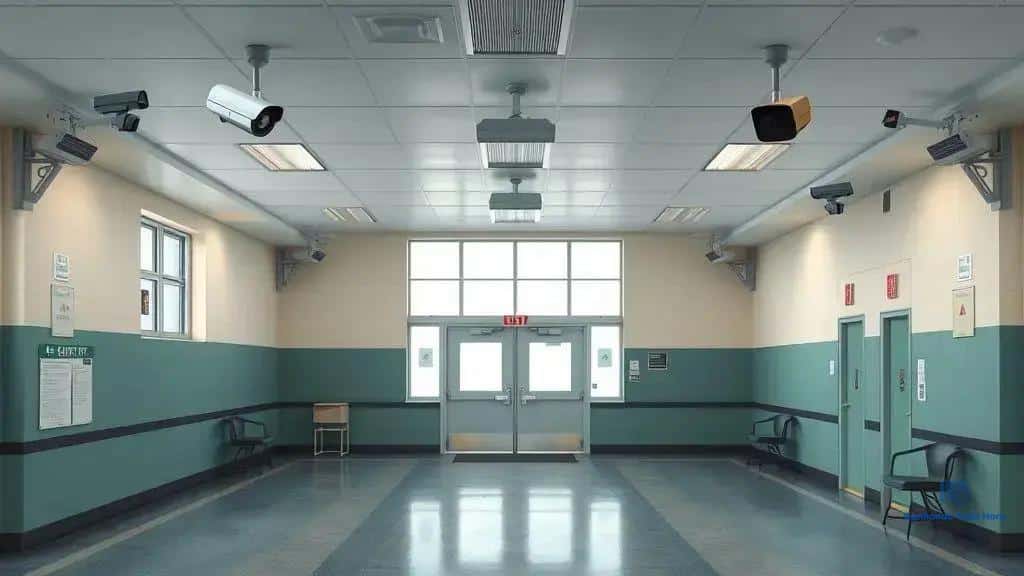School safety funding: why it matters now more than ever

Anúncios
School safety funding is essential for implementing crucial security measures, enhancing mental health resources, and ensuring a secure learning environment for students and staff.
School safety funding is a vital topic that touches every community. As concerns about student safety grow, understanding how this funding works becomes essential for parents, educators, and policymakers. What changes can it bring to our schools?
Anúncios
Understanding school safety funding
Understanding school safety funding is crucial for ensuring that students can learn in a secure environment. Funding aimed at enhancing safety measures in schools not only protects students but also fosters a sense of community and trust among parents and staff. By breaking down the different aspects of this funding, we can better appreciate its importance and impact.
Types of School Safety Funding
There are various forms of funding available to enhance school safety. These can include federal, state, and local funding sources. Understanding each type can help communities plan effectively for their safety needs.
- Federal Grants: These funds often target specific safety initiatives.
- State Budgets: Many states allocate budgets for safety improvements.
- Local Initiatives: Schools can apply for grants from local organizations.
Additionally, it’s important to recognize how this funding can be utilized effectively. Funds may go towards improved infrastructure, training for staff, or community programs aimed at increasing awareness. Each of these areas contributes to fostering a safer environment.
Challenges in Securing Funding
While the need for school safety funding is clear, securing these funds can be challenging. Many schools face competition for limited resources. Furthermore, a lack of awareness about available funding opportunities can hinder progress. To address these challenges, schools and communities must work together to raise awareness and advocate for necessary funding.
Anúncios
Another aspect to consider is the accountability associated with using school safety funding. Schools must ensure that allocated funds are managed effectively and transparently. This accountability can build trust within the community and encourage further investments in safety measures.
Ultimately, understanding school safety funding involves recognizing both its potential and the obstacles that may arise in securing it. Schools, parents, and communities need to advocate for responsible funding practices that promote student safety.
Key benefits of increased funding

Increased funding for school safety yields numerous benefits that directly impact the well-being of students and staff. By investing in safety measures, schools can create environments that support learning and growth. Understanding these benefits helps communities advocate for the necessary funding.
Enhanced Security Measures
One of the primary advantages of increased funding is the ability to implement enhanced security measures. Schools can invest in advanced security technologies that protect students and staff. These include:
- Improved Surveillance: Installing high-definition cameras helps monitor school grounds effectively.
- Access Control Systems: Secure entry points can prevent unauthorized access.
- Emergency Communication Systems: Effective communication tools ensure quick responses during crises.
With these systems in place, schools can respond rapidly to potential threats, promoting a safer atmosphere.
Increased Mental Health Resources
Another important benefit of additional funding is the expansion of mental health resources. Having access to trained counselors and support services can make a significant difference. More funding allows schools to:
- Hire Qualified Professionals: Increasing staff members who specialize in mental health.
- Provide Workshops: Offering programs on stress relief and coping strategies.
- Develop Support Groups: Creating safe spaces for students to discuss their challenges.
These resources are critical for addressing students’ emotional well-being and fostering a supportive environment.
Funding also contributes to staff training. When schools allocate resources for workshops and safety drills, they empower teachers and staff to handle emergencies more effectively. This preparation builds confidence and ensures that everyone knows their role during a crisis.
Furthermore, better funding allows schools to foster collaboration with local law enforcement. Partnering with police can lead to more safety programs and community involvement, which enhances the overall security plan. Working together, schools and law enforcement can develop strategies tailored to their unique needs.
How funding affects school security measures
Funding plays a crucial role in determining how effectively schools can implement security measures. When schools receive adequate financial resources, they are better equipped to protect their students and staff. This funding translates into tangible improvements in safety protocols and technologies.
Investments in Infrastructure
One of the direct impacts of funding is the enhancement of physical infrastructure. Schools can invest in stronger entry systems, such as secure doors and advanced locking mechanisms. These measures create a physical barrier against potential intruders.
- Upgrading Entry Points: Adding security features like card access systems can control who enters the building.
- Installing Fencing: Proper fencing around school grounds can deter unwanted visitors.
- Improving Lighting: Well-lit areas help ensure safety during after-school activities.
With these upgrades in place, students and staff can feel safer and more secure while on campus.
Adopting Technology
Increased funding allows schools to implement cutting-edge technology. This includes surveillance systems that monitor activity around the school. The presence of cameras can act as a deterrent to negative behavior.
- Video Monitoring Systems: High-definition cameras provide clear footage and improve overall security.
- Emergency Notification Systems: These systems ensure immediate communication in case of crises.
- Digital Incident Reporting Tools: Facilitating the reporting of suspicious activities enhances safety vigilance.
These technologies not only address immediate concerns but also foster a culture of safety within the school community. Moreover, schools with adequate funding can afford ongoing maintenance and upgrades to these systems, ensuring they remain effective over time.
Moreover, properly funded security measures can lead to better-trained staff. Schools can provide training for their teachers and administrators on how to respond in emergencies. Regular drills and training sessions can significantly improve response times during a crisis, enhancing the overall safety culture in the school.
In summary, the relationship between funding and school security measures is critical. The allocation of financial resources can dramatically enhance a school’s ability to protect its community, making it essential for schools to advocate for and secure necessary funding.
Successful funding initiatives in different states

Successful funding initiatives in different states demonstrate how financial resources can enhance school safety. Various programs provide valuable lessons in effectively utilizing funding to create secure educational environments. Exploring these initiatives can inspire others to advocate for similar programs in their communities.
California’s School Facility Program
In California, the School Facility Program allocates funding specifically for safety improvements. This program focuses on upgrading infrastructure in older schools, ensuring they meet modern safety standards. Some key aspects include:
- Seismic Retrofits: Strengthening buildings to withstand earthquakes.
- Modernized Security Systems: Updating surveillance and access systems for enhanced safety.
- Health and Safety Improvements: Ensuring facilities have proper ventilation and emergency exits.
These investments not only improve safety but also increase property values and community trust in public schools.
Florida’s Safe Schools Allocation
In Florida, lawmakers established a Safe Schools Allocation to provide funding directly to schools for safety measures. This funding can be used for a variety of safety enhancements, including:
- School Resource Officers: Hiring trained law enforcement officers to be present on campus.
- Safety Drills: Funding for regular practice drills to ensure everyone knows emergency procedures.
- Emergency Training: Offering training for staff on crisis intervention techniques.
This initiative has had a positive impact, leading to a more secure atmosphere where both students and staff feel safe.
Texas’ School Safety Grant Program
Texas has implemented the School Safety Grant Program, focusing on providing financial resources for security upgrades. Schools can apply to receive funding for initiatives such as:
- Building Security Assessments: Evaluating current safety measures and identifying areas for improvement.
- Surveillance Equipment: Installing or upgrading cameras and monitoring systems.
- Behavioral Threat Assessments: Creating teams that identify and address potential risks to student safety.
By investing in these programs, Texas schools have significantly improved their safety protocols and crisis response strategies.
These examples from California, Florida, and Texas illustrate that successful funding initiatives make substantial differences in school safety. Each program showcases different approaches tailored to meet the needs of local communities. Implementing similar initiatives elsewhere can lead to safer educational environments for students and staff alike.
Challenges in securing school safety funding
Securing school safety funding presents several challenges that can hinder the development of safe environments for students. Understanding these barriers is essential for advocates looking to make changes and improve outcomes for schools.
Budget Constraints
Many schools face budgetary constraints that limit their ability to allocate funds for safety measures. They often prioritize basic educational needs over security enhancements. For instance, schools might struggle to cover:
- Teacher Salaries: Basic staffing needs may take precedence over safety funding.
- Maintenance Costs: Upkeep of facilities can consume the budget significantly.
- Facility Upgrades: Limited funds might prevent schools from updating safety systems.
This situation leads to tough decisions where safety can sometimes be overlooked.
Lack of Awareness
Another significant challenge is the lack of awareness regarding available funding opportunities. Many administrators and community members may not know about grants or state programs aimed at enhancing school safety. This lack of information can prevent schools from applying for crucial funds. Some common issues include:
- Uninformed Stakeholders: School boards and parents may not understand available resources.
- Complex Application Processes: Some funding programs have lengthy and complicated application processes, deterring applications.
- Limited Outreach: Insufficient marketing of funding opportunities can lead to missed chances for support.
Without clear communication about these resources, schools may miss essential funding options.
Political and Legislative Issues
Political factors also play a role in securing school safety funding. Policies regarding education and safety often change based on local and state government priorities. This unpredictability can lead to:
- Fluctuating Funding Levels: Inconsistent support from local or state government makes long-term planning difficult.
- Policy Changes: Shifts in political leadership can affect prioritization of safety funding.
- Partisan Divides: Disagreement on safety measures can stall funding initiatives.
Given these complexities, schools and advocates must navigate a challenging landscape to secure the funding needed for safe educational environments.
Overall, these challenges in securing school safety funding highlight the need for increased awareness, advocacy, and strategic planning. Only by addressing these barriers can schools work towards creating safer spaces for their students and staff.